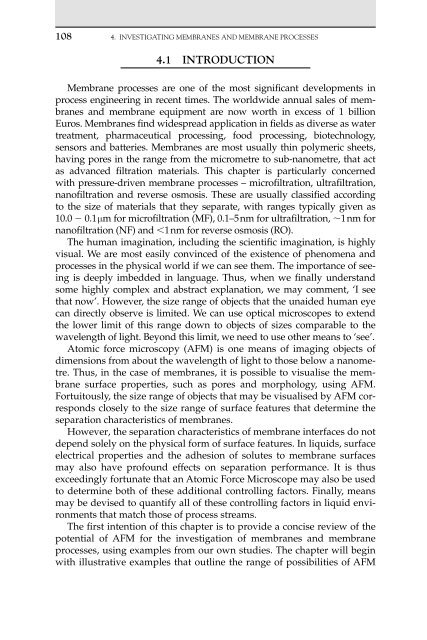W. Richard Bowen and Nidal Hilal 4
W. Richard Bowen and Nidal Hilal 4
W. Richard Bowen and Nidal Hilal 4
- No tags were found...
Create successful ePaper yourself
Turn your PDF publications into a flip-book with our unique Google optimized e-Paper software.
108 4. INvEsTIgATINg MEMbRANEs ANd MEMbRANE PROCEssEs<br />
4.1 InTRODUCTIOn<br />
Membrane processes are one of the most significant developments in<br />
process engineering in recent times. The worldwide annual sales of membranes<br />
<strong>and</strong> membrane equipment are now worth in excess of 1 billion<br />
Euros. Membranes find widespread application in fields as diverse as water<br />
treatment, pharmaceutical processing, food processing, biotechnology,<br />
sensors <strong>and</strong> batteries. Membranes are most usually thin polymeric sheets,<br />
having pores in the range from the micrometre to sub-nanometre, that act<br />
as advanced filtration materials. This chapter is particularly concerned<br />
with pressure-driven membrane processes – microfiltration, ultrafiltration,<br />
nanofiltration <strong>and</strong> reverse osmosis. These are usually classified according<br />
to the size of materials that they separate, with ranges typically given as<br />
10.0 � 0.1 �m for microfiltration (MF), 0.1–5 nm for ultrafiltration, �1 nm for<br />
nanofiltration (NF) <strong>and</strong> �1 nm for reverse osmosis (RO).<br />
The human imagination, including the scientific imagination, is highly<br />
visual. We are most easily convinced of the existence of phenomena <strong>and</strong><br />
processes in the physical world if we can see them. The importance of seeing<br />
is deeply imbedded in language. Thus, when we finally underst<strong>and</strong><br />
some highly complex <strong>and</strong> abstract explanation, we may comment, ‘I see<br />
that now’. However, the size range of objects that the unaided human eye<br />
can directly observe is limited. We can use optical microscopes to extend<br />
the lower limit of this range down to objects of sizes comparable to the<br />
wavelength of light. Beyond this limit, we need to use other means to ‘see’.<br />
Atomic force microscopy (AFM) is one means of imaging objects of<br />
dimensions from about the wavelength of light to those below a nanometre.<br />
Thus, in the case of membranes, it is possible to visualise the membrane<br />
surface properties, such as pores <strong>and</strong> morphology, using AFM.<br />
Fortuitously, the size range of objects that may be visualised by AFM corresponds<br />
closely to the size range of surface features that determine the<br />
separation characteristics of membranes.<br />
However, the separation characteristics of membrane interfaces do not<br />
depend solely on the physical form of surface features. In liquids, surface<br />
electrical properties <strong>and</strong> the adhesion of solutes to membrane surfaces<br />
may also have profound effects on separation performance. It is thus<br />
exceedingly fortunate that an Atomic Force Microscope may also be used<br />
to determine both of these additional controlling factors. Finally, means<br />
may be devised to quantify all of these controlling factors in liquid environments<br />
that match those of process streams.<br />
The first intention of this chapter is to provide a concise review of the<br />
potential of AFM for the investigation of membranes <strong>and</strong> membrane<br />
processes, using examples from our own studies. The chapter will begin<br />
with illustrative examples that outline the range of possibilities of AFM
















